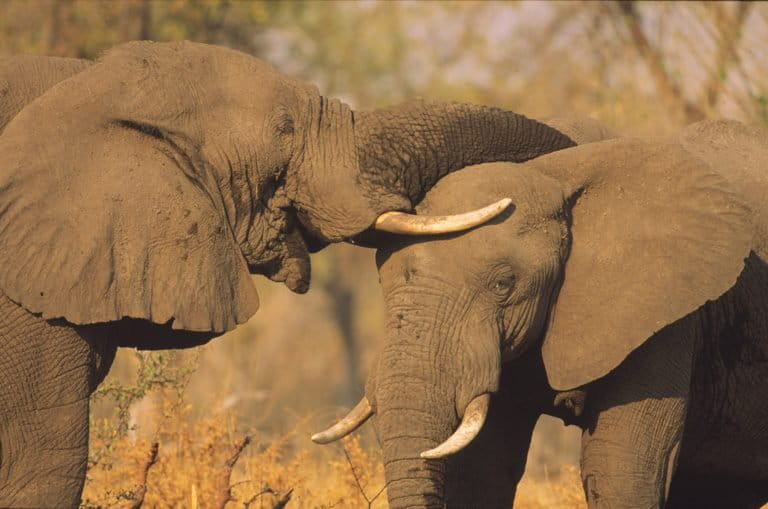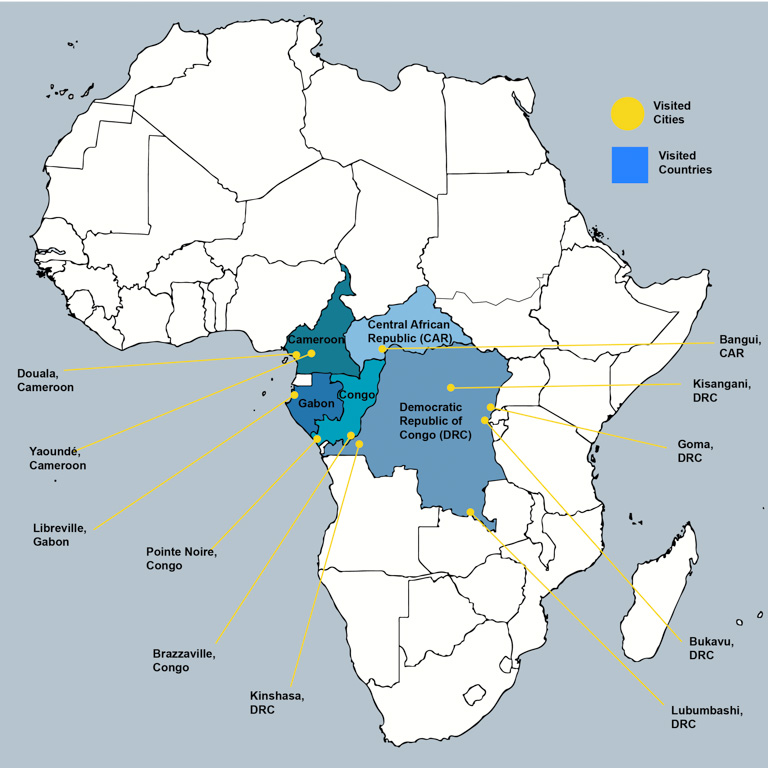- A series of undercover investigations by the NGO TRAFFIC over several years in five Central African countries has revealed a shift in the region from local markets for ivory to an ‘underground’ international trade.
- The resulting report, published Sept. 7, finds that organized crime outfits, aided by high-level corruption, are moving ivory out of Central African to markets abroad, especially in China and other parts of Asia.
- A 2013 study found that elephant numbers in Central Africa’s forests dropped by 62 percent between 2002 and 2011.
The ivory trade in Central Africa appears to be diminishing, according to a new report from TRAFFIC, a U.K.-based watchdog NGO. But that finding might be misleading, say the authors, as surging demand for ivory now comes from beyond these countries’ borders.
“The generally positive news contained in this report about the decline of Central African ivory markets needs to be weighed against the fact that, throughout this sub-region, there are still many issues to be addressed and underlying trade dynamics may be shifting beyond local markets,” said Sone Nkoke, a wildlife project officer with TRAFFIC and the lead author of the report, in a statement.
In a series of undercover investigations supported by WWF and the U.S. and French governments over several years, TRAFFIC researchers tracked the near-disappearance in five Central African countries of open ivory markets. But the conversations and interactions they had with traders, vendors, and middlemen during the research also revealed that Gabon, Cameroon, Central African Republic, the Republic of Congo, and the Democratic Republic of Congo (DRC) are integral sources and waypoints in the international ivory trade.

In the region, authorities confiscated nearly 54,000 kilograms (119,050 pounds) of ivory in Central Africa, representing ivory from more than 5,700 elephants. The authors estimate that about four times that much is leaking out of Central African borders. TRAFFIC published its findings on Sept. 7.
A 2013 study found that elephant numbers in the region’s forests dropped by 62 percent between 2002 and 2011. On the continent, WWF estimates that one elephant is killed every 15 minutes for its ivory, and some experts fear that the animal could face extinction within a decade if poaching continues at current rates.
Of the five countries that are the focus of the TRAFFIC report, only Cameroon still has a legal ivory trade. The remaining countries have outlawed it. That step, banning the sale of ivory within a country’s borders, seems to have provided the foundation of a deterrent, at least for its open sale in most of the countries.
“Law enforcement efforts and increasing interventions from the authorities were highlighted throughout the region by retailers and carvers as having a detrimental impact on the ivory business,” the authors wrote.
The authors report a shift in demand, away from local demand for carved ivory and toward international, “underground” demand for raw ivory products. It has even led African ivory carvers to switch to wood carving as their primary focus.
The total amount of ivory found by the investigators in open markets in 2014 and 2015 totaled less than a kilogram in Cameroon, CAR, the Republic of Congo and Gabon. By contrast, they had found 400 kilograms in 2007, and over 900 kilograms in 1999.
Surveys did reveal that markets in Kinshasa, DRC, typically had a steady supply of 400 to 500 kilograms over the same time period. However, in May 2017, the DRC government announced it would clamp down on its capital’s ivory market.

The investigation revealed several common routes by which ivory gets from elephants killed in the region’s savannas and forests into the hands of international buyers. Though local middlemen are involved in the trade, the foreign buyers were often from China, but also from Vietnam and Malaysia.
China remains the world’s largest market for ivory but has committed to ending the legal trade of ivory by the end of 2017.
The rise in international demand for raw ivory — and the commensurate payoff for key players involved in getting ivory to countries such as China where consumer demand is high — has driven Africa’s elephants into crisis.
“Real concerted efforts are needed to address the serious decline in elephant populations throughout Central Africa: this is no longer just a wildlife issue, but an ecological disaster strongly driven by highly-organized crime syndicates,” Nkoke said. “Criminals involved in international ivory trade are regularly exploiting weak [state] governance, and official collusion, confusion and corruption.”
That corruption appears to make the ivory trade possible in some instances, according to TRAFFIC. The investigators reported that senior government officials and armed forces in DRC are involved in procuring ivory.

A seller told TRAFFIC researchers that government officials and UN peacekeepers — soldiers sent from other countries by the UN to help quell conflicts — have “the luxury to move around the country frequently,” allowing them to transport ivory from poached elephants to buyers in Kinshasa and beyond. Similarly, a customs official working in Kinshasa said that his office had found UN peacekeepers from African and Asian countries trying to smuggle ivory out of DRC.
Even without this corruption, ineffective enforcement of laws intended to protect wildlife and stamp out the ivory trade hampers results. Researchers found that stockpiles of seized ivory in DRC are sometimes kept unprotected in government offices, where it could find its way into the hands of illicit traders.
The report’s authors compiled a list of recommended actions. Many of these center on improved enforcement and alignment of national laws with the commitments the countries have made through regional and international mechanisms, such as the Convention on International Trade in Endangered Species of Wild Fauna and Flora (CITES) and the African Strategy on Combating Illegal Exploitation and Illegal Trade in Wild Fauna and Flora in Africa.
“Clearly Central African countries face significant governance and enforcement challenges in regulating elephant poaching and ivory trafficking,” said Paulinus Ngeh, who directs the TRAFFIC Central Africa Regional Office in Cameroon, in the statement. “They urgently need to ramp up their efforts to implement a range of commitments that they have made at multiple international fora over the last ten years.”

CITATION
Maisels, F., Strindberg, S., Blake, S., Wittemyer, G., Hart, J., Williamson, E. A., … & Bakabana, P. C. (2013). Devastating decline of forest elephants in Central Africa. PloS one, 8(3), e59469.
Banner image of a forest elephant (Loxodonta cyclotis) by Thomas Breuer, CC BY 2.5, via Wikimedia Commons
FEEDBACK: Use this form to send a message to the author of this post. If you want to post a public comment, you can do that at the bottom of the page.
Follow John Cannon on Twitter: @johnccannon














